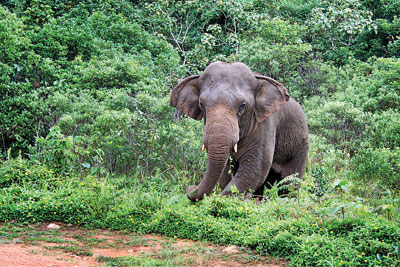News
Environmental groups hit out at moves to relocate the last two elephants of Sinharaja
View(s):Four major environmental organizations have raised strong voices of protest against reported moves to relocate the last two elephants living in the Sinharaja Rainforest, a World Heritage Site.

One of the majestic elephants of Sinharaja.Pic by Dulan Ranga Vidanapathirana
“We are appalled that a political decision has been made to capture and relocate the last two elephants remaining in the Sinharaja Rainforest, as indicated by media reports,” states the Wildlife & Nature Protection Society of Sri Lanka (WNPS), the Federation of Environmental Organizations — Sri Lanka (FEO), the Wildlife Conservation Society of Galle and Rainforest Sri Lanka, while suggesting several solutions to prevent people coming face-to-face with these elephants.
The ‘relocation’ is being proposed following an incident in which a villager on the borders of the forest who went out of his home in the middle of the night, without a torch or other illumination, to defecate in the open, coming upon an elephant feeding there, thus meeting an untimely death, according to these organizations.
Explaining that walking out in the middle of the night in areas bordering any forest, without the advantage of a light, has its perils, and not just from elephants. These organizations point out that this unfortunate man may have met his end from the bite or attack of half a dozen other creatures that inhabit Sinharaja and its boundaries.
“Had his death been caused by any other, this matter would have been recorded as an unfortunate accident but as it was an elephant, the unscrupulous have taken advantage of this. It is hoped that sense will prevail and rather than capturing these last two of their kind, they be studied and their role as elephants in this unique and precious forest will be better understood,” the organizations state.
They provide the following possible solutions:
- Collar the elephants and track their movements so that villagers may be warned if the animals are in the vicinity of their dwellings.
- Guinea B (Sin. Mana) grass grows up to a height of six feet right to the edge of the roads frequented by villagers. This wall of foliage frequently prevents elephant and human knowing of the others’ presence until an elephant suddenly steps through. If this grass is cleared for several metres from the edge of the roads both elephant and human will see the other in time and so avoid confrontation.
- The Department of Wildlife Conservation (DWC) Office is at Kudawa, far from the usual haunts of these elephants which tend to be around the Ensalwatta area. If the DWC builds another office at Ensalwatta, DWC officers could respond to potential situations of conflict far quicker than at present and take appropriate action to resolve potential conflicts and, thereby, save lives.
Explaining that there is a draft National Management Plan for the Conservation of the Wild Elephant in Sri Lanka, a comprehensive document that addresses all aspects necessary to preserve the last populations of the wild elephant, inclusive of measures to reduce human-elephant conflicts that often result in tragedy for both; as it has and will, in this case, the organizations lament that this document has sat on the shelves of the Ministry of Wildlife awaiting adoption for some time now.
“The draft Plan clearly states that relocation of elephants does not work, and alternative solutions are proposed. Of good example is the so-called Elephant Holding Grounds at Horowapathana, a fancy name for an Elephant Prison, to which so-called ‘Problem Elephants’, all male, are condemned. As per a media statement made by the present Deputy Minister for Wildlife, who recognizes its failure, of all the elephants imprisoned there, only 16 remain, the rest having either found means of escape, or died. After all, even elephants seek freedom when unjustly imprisoned,” they state, adding that it is vital that the draft National Management Plan for the Conservation of the Wild Elephant in Sri Lanka is adopted and implemented for the safety of both human and elephant, and for the long-term preservation of the latter.
Going back in time these organizations state: “Elephants once roamed the length and breadth of this country, from the heights of Horton Plains to the coastal scrub forests of the Dry Zone. Estimates of their numbers in the 1800s ranged from 30,000 and above. Then came conquest and colonialism and their population was systematically reduced as they were driven down to the Dry Zone. An estimate of around 6,000 was arrived at in a survey of 2011, though the methodology used was far from perfect. Notwithstanding, the numbers have reduced along with the rise in number of the human population, and the resulting loss in habitat over the last 150 years.
“Today, there is a population of about 30 elephants in the Peak Wilderness Sanctuary and just these two at Sinharaja, the last remnants of Wet Zone mountain rainforest elephants left in Sri Lanka. When these remaining two are taken away, the last of this particular population would have gone. It could be argued that being both males, that they are doomed anyway. Yet there is time to study their relationship with the forest to discover if they play a role in its biological equilibrium? Sinharaja continues to hold many natural secrets, even today.”
Sri Lanka has a 3,000-year documented record of conservation, driven by a philosophy that values all living beings. Is that to be sacrificed to politics and personal gain, ask the four organizations.

